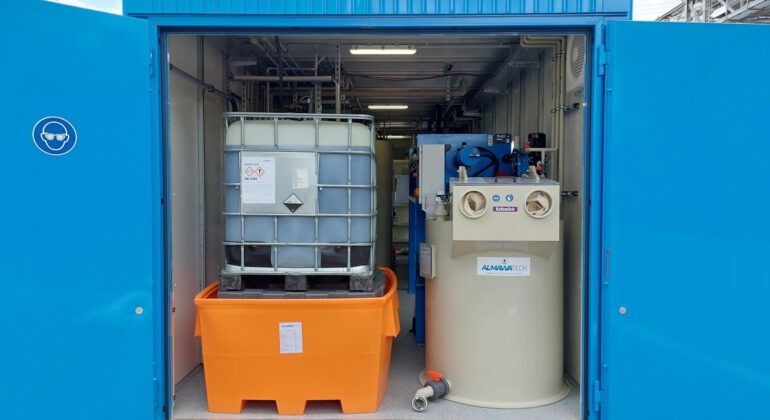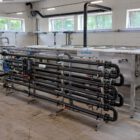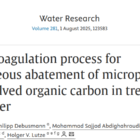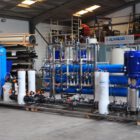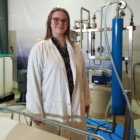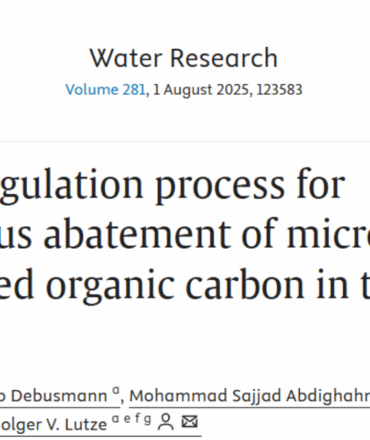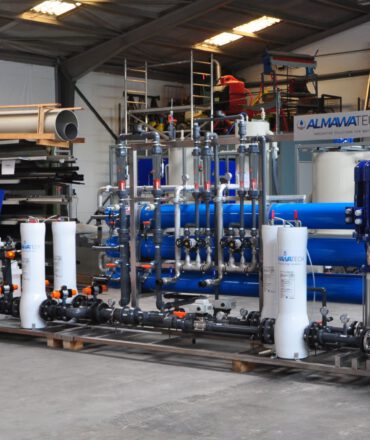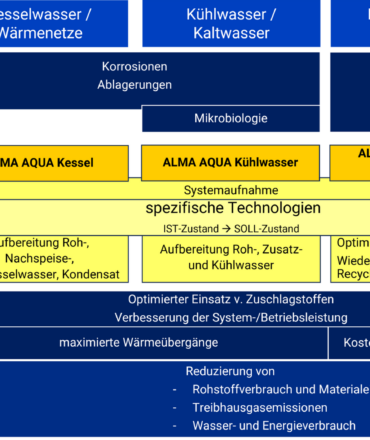Heute geht es um das wichtige Thema der Abwasserbehandlung und die Rolle, die Fällmittel dabei spielen. Wenn es um die chemische Behandlung von Abwasser in Fällungsanlagen geht, ist es von entscheidender Bedeutung das richtige Fällmittel auszuwählen, um eine effektive Behandlung zu gewährleisten.
In diesem Artikel werden wir Ihnen nützliche Tipps und Empfehlungen zur Auswahl des richtigen Fällmittels für Ihre spezifischen Anforderungen geben. Erfahren Sie mehr über die verschiedenen Typen von Fällmitteln, die Anwendungsbereiche, die Faktoren, die die Effizienz beeinflussen, sowie Best Practices bei der Verwendung von Fällmitteln.
Inhaltsverzeichnis
Bedeutung von Fällmitteln in der Abwasserbehandlung
Die Auswahl und Dosierung des optimalen Fällmittels ist vor allem in der Behandlung von Abwässern aus dem Non-Food Bereich ein wesentlicher Aspekt der Abwasserbehandlung. Diese Betriebsmittel spielen eine wichtige Rolle bei der Entfernung von zum Beispiel Schwermetallen, Phosphaten oder Kohlenwasserstoffen aus dem Abwasser.
Eine der größten Herausforderungen bei der Abwasserreinigung ist die Komplexität und Vielfalt der Verunreinigungen. Fällmittel helfen, die Abwasserreinigung effektiver zu gestalten, indem sie die Schadstoffe gezielt ausfällen und somit deren Entfernung erleichtern. Allerdings erfordert ihre Verwendung sorgfältige Dosierung und Kontrolle.
Als Spezialist für Industrieabwasserreinigung verfügen wir über das erforderliche Know-how, um unsere Kunden bei der Auswahl der geeigneten Fällmittel und bei der Überwachung des Behandlungsprozesses zu unterstützen.
Was sind Fällmittel?
Definition und Funktionsweise von Fällmitteln
Fällmittel sind chemische Substanzen, die Abwässern zudosiert werden, um gelöste Verbindungen in ungelöste partikuläre Stoffe zu überführen. Diese ungelösten Stoffe sind im Gegensatz zu gelösten Stoffen durch einfache physikalischen Verfahren wie Sedimentation oder Flotation abtrennbar.
Die Dosierung und der Einsatz von Fällmitteln hängen von der Art der Verunreinigung und den gesetzlichen Anforderungen an die Abwasserbehandlung ab. Daher ist eine sorgfältige Überwachung und Kontrolle des Reinigungsprozesses unerlässlich.
Arten von Fällmitteln
Es gibt verschiedene Arten von Fällmitteln, die in der Abwasserbehandlung Verwendung finden. Ein Großteil der abwassertechnischen Anwendungen werden von drei Arten von Fällmitteln abgedeckt. Sie basieren entweder auf Eisensalzen, Aluminiumsalzen oder gehören zu den sulfidischen Fällmitteln.
Aluminiumbasierende Fällmittel haben den Vorteil, dass sie ein geringes spezifisches Molekulargewicht aufweisen. Dies ist insbesondere bei der Verwendung von Fällmitteln in Druckentspannungsflotationen ein wichtiger Einflussfaktor. Je niedriger das spezifische Gewicht der entstehenden Schlammflocken, desto einfacher flotieren die Schlammflocken. Die am häufigsten verwendeten Fällmittel auf der Basis von aluminiumhaltigen Verbindungen sind: Polyaluminiumhydroxidchlorid, Dialuminiumchloridpentahydroxid und Aluminiumsulfat.
Eisenbasierende Fällmittel, insbesondere Eisen(III)-Chlorid ist das wohl am häufigsten verwendete Fällmittel. Aufgrund der hohen Bindungsaffinität des dreiwertigen Eisens zu dreiwertigen Phosphaten wird das Fällmittel oft zur Phosphatelimination z.B. in kommunalen Kläranlagen eingesetzt.
Fällmittel auf der Basis von Aluminium- oder Eisensalzen werden in Verbindungen mit Neutralisationsmitteln verwendet. Diese Neutralisationsmittel verschieben den pH-Wert des Abwasser aufgrund ihrer Hydroxid-Gruppe. Dementsprechend wird hier von einer Hydroxidfällung oder Neutralisationsfällung gesprochen.
Diese Arten der Fällung stoßen an ihre Grenzen, wenn:
- sehr tiefe Grenzwerte erreicht werden müssen,
- eine hohe Konzentration an Komplexbildnern im Abwasser vorhanden ist, oder
- Verbindungen im Abwasser vorliegen, die sich durch eine Hydroxidfällung nicht ausfällen lassen.
Für diese Aufgabenstellungen werden nachgeschaltet zur Hydroxidfällung eine sogenannte sulfidische Fällung vorgenommen. Wie der Name schon sagt, werden dafür Fällmittel auf der Basis von Schwefelverbindungen genutzt. Die am häufigsten Verwendeten sulfidischen Fällmittel sind Natriumsulfid und Organosulfid. Mit der Kombination aus Hydroxid- und Sulfid-Fällung lassen sich oftmals Reinigungsleistung von > 99 % erreichen.
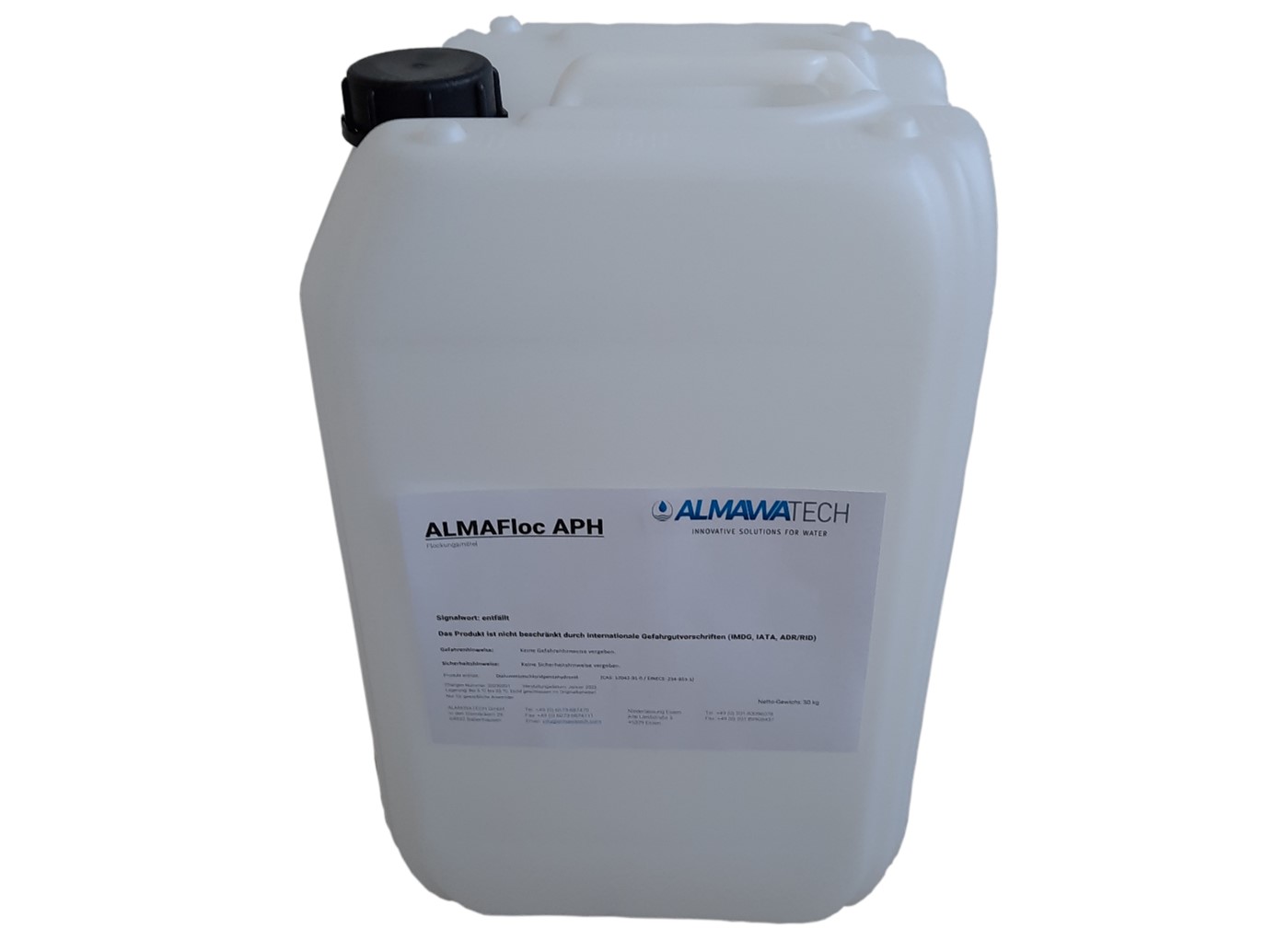
Foto: ALMAFloc APH (zum Produkt) Kombinationsprodukt aus Fällmittel, Flockungshilfsmittel und Neutralisationsmittel
Auswahl des richtigen Fällmittels
Analyse der Abwasserproben
Die Auswahl des richtigen Fällmittels ist entscheidend für eine effektive Industrieabwasserreinigung. Um das passende Fällmittel auszuwählen, müssen zuerst Abwasserproben analysiert werden. Durch die Analyse können die Art und Konzentration der Verunreinigungen bestimmt werden, die im Abwasser vorhanden sind.
Die Analyse der Abwasserproben gibt Aufschluss darüber, welches Fällmittel am besten geeignet ist, um die spezifischen Verunreinigungen zu entfernen. Eine falsche Wahl des Fällmittels kann zu einer ineffektiven Reinigung führen, da nicht alle Verunreinigungen entfernt werden können.
Unser erfahrenes Team von Experten in der Industrieabwasserreinigung ist darauf spezialisiert, Abwasserproben zu analysieren und das passende Fällmittel auszuwählen. Wir berücksichtigen dabei nicht nur die Art der Verunreinigung, sondern auch die gesetzlichen Anforderungen und die spezifischen Bedürfnisse unserer Kunden.
Durch die Auswahl des richtigen Fällmittels und eine sorgfältige Überwachung des Reinigungsprozesses können wir sicherstellen, dass unser Kunde eine effektive und umweltverträgliche Abwasserbehandlung erhält.
Beratung durch Experten
Die Auswahl des richtigen Fällmittels ist entscheidend für eine effektive Industrieabwasserreinigung. Unsere erfahrenen Experten beraten Sie gerne bei der Wahl des passenden Fällmittels für Ihre spezifischen Bedürfnisse. Kontaktieren Sie uns für eine Beratung bzgl. der optimalen Chemikalienauswahl und senden Sie uns eine Abwasserprobe zu, die wir in unserem Labor analysieren.
Faktoren, die die Effizienz von Fällmitteln beeinflussen
pH-Wert des Abwassers
Der pH-Wert des Abwassers ist einer der wichtigsten Faktoren, der die Effizienz von Fällmitteln in der Industrieabwasserreinigung beeinflusst. Der pH-Wert ist ein Maß für die Konzentration von Wasserstoffionen im Abwasser und kann auf einer Skala von 0 bis 14 gemessen werden. Ein pH-Wert von 7 ist neutral, Werte unter 7 sind sauer und Werte über 7 sind alkalisch.
Das Fällverfahren beruht auf der chemischen Reaktion von Fällmitteln mit gelösten Schadstoffen im Abwasser. Dabei bilden sich unlösliche Stoffe, sogenannte Flocken, die dann abgeschieden werden können. Der pH-Wert beeinflusst diese Reaktionen auf verschiedene Weise. Wenn der pH-Wert zu hoch oder zu niedrig ist, kann dies die Bildung von Flocken beeinträchtigen oder sogar verhindern. Ein zu saures oder zu alkalische Milieu kann die Wirkung von Fällmitteln stark beeinträchtigen.
Um sicherzustellen, dass das Fällmittel optimal wirkt, muss der pH-Wert des Abwassers daher sorgfältig überwacht und reguliert werden. Hierbei ist es wichtig, dass der pH-Wert im optimalen Bereich für das jeweilige Fällmittel gehalten wird. Durch die richtige Wahl des Fällmittels und die Überwachung des pH-Wertes können Unternehmen eine effektive und effiziente Industrieabwasserreinigung gewährleisten.
Konzentration von gelösten Stoffen
Die Konzentration von gelösten Stoffen im Abwasser ist ein wichtiger Faktor, der die Effizienz von Fällmitteln in der Industrieabwasserreinigung beeinflusst. Wenn die Konzentration von Schadstoffen im Abwasser zu hoch ist, kann dies die Wirksamkeit von Fällmitteln beeinträchtigen.
Das Fällverfahren beruht auf der chemischen Reaktion von Fällmitteln mit den gelösten Schadstoffen im Abwasser. Dabei bilden sich Flocken, die dann abgeschieden werden können. Wenn die Konzentration von Schadstoffen im Abwasser zu hoch ist, kann dies die Bildung von Flocken beeinträchtigen oder verhindern. In diesem Fall kann es erforderlich sein, höhere Dosen von Fällmitteln einzusetzen, um eine ausreichende Entfernung der Schadstoffe zu gewährleisten.
Andererseits kann eine zu niedrige Konzentration von Schadstoffen im Abwasser ebenfalls die Wirksamkeit von Fällmitteln beeinträchtigen. In diesem Fall können die Fällmittel nicht effektiv mit den Schadstoffen im Abwasser reagieren und die Bildung von Flocken wird verhindert.
Daher ist es wichtig, dass die Konzentration von Schadstoffen im Abwasser sorgfältig überwacht und reguliert wird, um sicherzustellen, dass die Fällmittel effektiv arbeiten können.
Temperatur des Abwassers
Fällmitteln bei der Abwasserreinigung beeinflusst. In der Regel arbeiten Fällmittel bei höheren Temperaturen effektiver als bei niedrigeren Temperaturen. Dies liegt daran, dass bei höheren Temperaturen die chemischen Reaktionen zwischen den Fällmitteln und den im Abwasser enthaltenen Stoffen schneller und effektiver ablaufen können.
Wenn das Abwasser jedoch zu heiß ist, kann dies auch zu Problemen führen. Ein zu hoher pH-Wert und eine zu hohe Temperatur können dazu führen, dass Fällmittel inaktiv werden oder nicht richtig funktionieren. Darüber hinaus kann eine zu hohe Temperatur die Lebensdauer von Fällmitteln verkürzen und die Gefahr von Verstopfungen in Rohren und Leitungen erhöhen.
Best Practices bei der Verwendung von Fällmitteln
Richtige Dosierung
Fällmittel sind ein unverzichtbarer Bestandteil der Abwasserbehandlung in der Industrie. Dabei ist es wichtig, dass das Fällmittel in der richtigen Dosierung eingesetzt wird, um eine effiziente Abwasserreinigung zu gewährleisten. Eine Überdosierung führt zu unnötigen Kosten und kann sogar zu Schäden an den Anlagen führen. Eine Unterdosierung hingegen kann die Wirksamkeit des Fällmittels einschränken.
Die Dosierung von Fällmitteln hängt von verschiedenen Faktoren ab, wie beispielsweise der Art des Abwassers, der Konzentration der gelösten Stoffe und dem gewünschten Reinigungsgrad. Es empfiehlt sich daher, Abwasserproben zu analysieren, um die optimale Dosierung zu ermitteln.
Um eine optimale Dosierung zu erreichen, ist es auch wichtig, das Fällmittel gleichmäßig und kontinuierlich in das Abwasser einzubringen. Hierfür können spezielle Dosiereinrichtungen eingesetzt werden.
Hier finden Sie einen Überblick über unsere Dosierstationen für Fällmittel, Neutralisationsmittel und Flockungshilfsmittel.
Vermeidung von Überdosierung
Die richtige Dosierung von Fällmitteln ist entscheidend für eine effektive Abwasserbehandlung. Um Überdosierungen zu vermeiden, sollte das Abwasser vor der Zugabe von Fällmitteln gründlich analysiert werden. Auf diese Weise kann die Dosierung genau bestimmt werden, um die gewünschte Flockenbildung und die erforderliche Entfernung von Schadstoffen zu gewährleisten.
Ein weiterer wichtiger Faktor bei der Vermeidung von Überdosierungen ist die Überwachung des Abwasserstroms und der Zusatzstoffe. Es ist wichtig, die Menge der zugeführten Fällmittel kontinuierlich zu überwachen und entsprechend anzupassen, um eine Überdosierung zu vermeiden.
Eine Überdosierung von Fällmitteln kann nicht nur zu erhöhten Kosten führen, sondern auch zu unerwünschten Auswirkungen auf die Abwasserbehandlung und Umwelt führen. Um dies zu vermeiden, sollten Betreiber von Abwasseranlagen eine regelmäßige Schulung ihrer Mitarbeiter durchführen und die Einhaltung von Best Practices in der Verwendung von Fällmitteln sicherstellen.
Fazit
Die Auswahl und Verwendung des richtigen Fällmittels ist entscheidend für die effektive Reinigung von Industrieabwässern. Hier sind einige Empfehlungen, die bei der Auswahl und Verwendung von Fällmitteln berücksichtigt werden sollten:
- Analyse der Abwasserproben: Bevor ein Fällmittel ausgewählt wird, sollte eine gründliche Analyse der Abwasserproben durchgeführt werden, um die Art und Konzentration der zu entfernenden Stoffe zu bestimmen.
- Dosierung: Die Dosierung von Fällmitteln sollte gemäß den Herstellerangaben erfolgen. Eine Überdosierung kann zu Problemen wie Schlammablagerungen führen, während eine Unterdosierung die Effektivität der Reinigung beeinträchtigt.
- Vermeidung von Überdosierung: Um eine Überdosierung zu vermeiden, sollte die Dosierung schrittweise erhöht werden, bis die optimale Menge erreicht ist. Die Menge an Fällmittel sollte auch an die Schwankungen des Abwassers angepasst werden.
- Überwachung: Es ist wichtig, den Reinigungsprozess regelmäßig zu überwachen, um sicherzustellen, dass das Fällmittel ordnungsgemäß funktioniert und die gewünschten Ergebnisse erzielt werden.
- Entsorgung: Die Entsorgung von Rückständen nach der Reinigung sollte gemäß den Umweltvorschriften erfolgen.
Durch die Berücksichtigung dieser Empfehlungen können Sie sicherstellen, dass Sie das beste Fällmittel für Ihre Anforderungen auswählen und es optimal nutzen. Wenn Sie Hilfe bei der Auswahl oder Anwendung von Fällmitteln benötigen, kontaktieren Sie unsere Experten und lassen Sie uns Laborversuche mit Ihrem Abwasser durchführen, um das optimale Fällmittel zu ermitteln.


